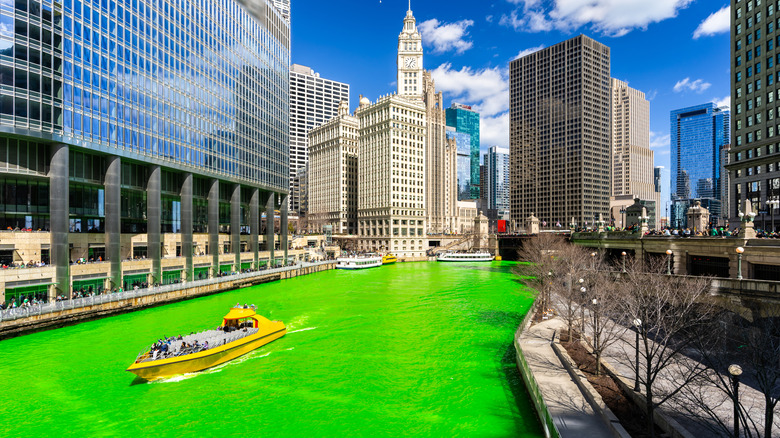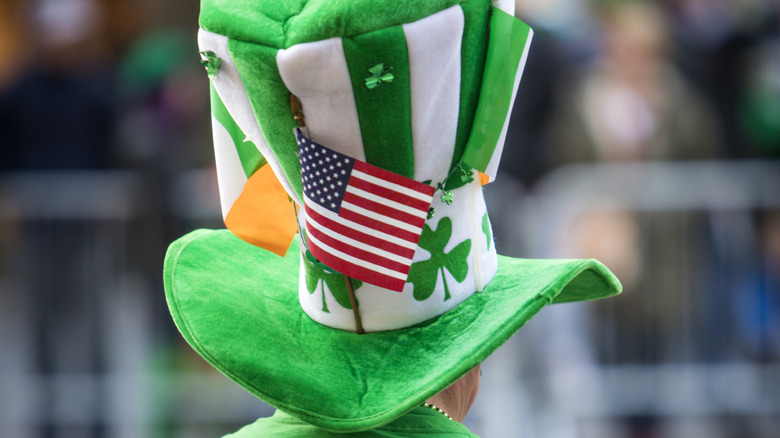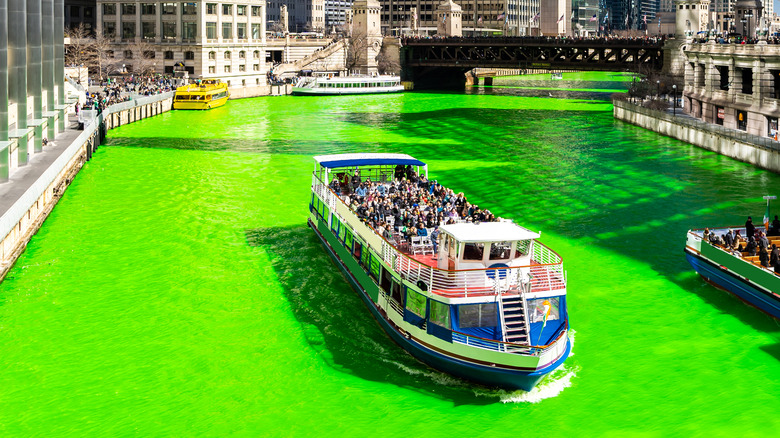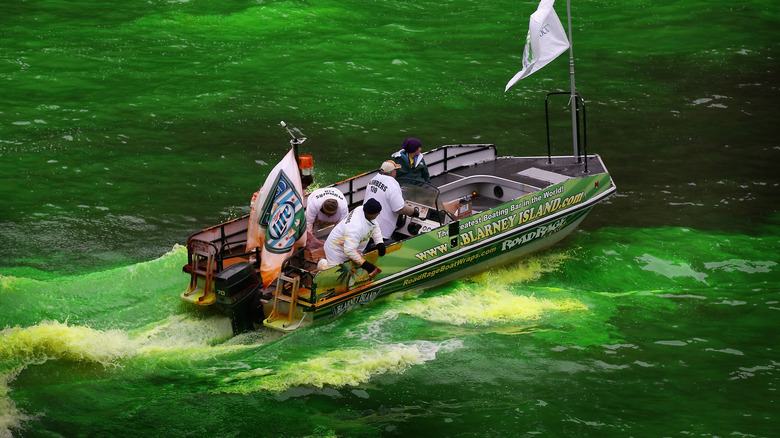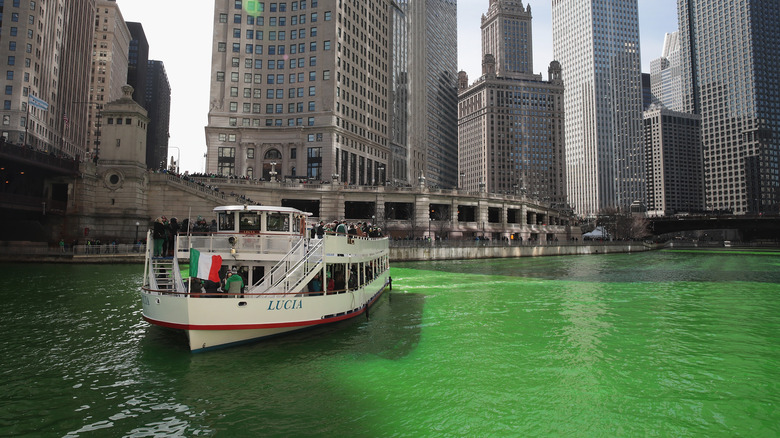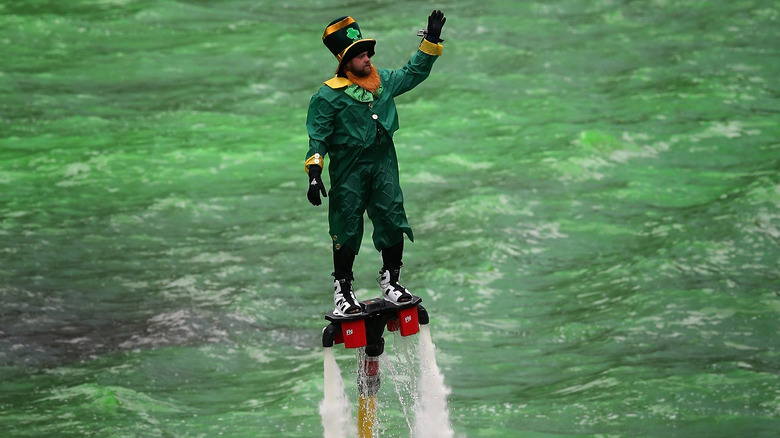How The Annual Dyeing Of The Chicago River Became A St. Patrick's Day Tradition
It's become an annual event in the city of Chicago: dying the river green, for at least a few hours, on the Saturday before St. Patrick's Day. The tradition of dying the Chicago River green dates back to 1962, according to History. But the tradition was born of an era when putting dye in the water was not all fun and games. When Chicago Mayor Richard J. Daley took office in 1955, according to Mental Floss, one of his goals was to clean up the polluted Chicago River in order to make the waterfront more appealing for development.
At the mayor's authorization, city workers used green dye in their effort to clean up the river. Using the special dye that latched on to contaminants, workers were able to locate where illegal discharges were coming from, and stop pollution at the source. The green dye would also stain clothing, according to Mental Floss. One day in 1961, the chairman of the St. Patrick's Day Parade committee, who was also a member of the local plumbers' union, saw a colleague's work clothes stained green, and had a new idea.
St. Patrick's Day in America is festive
As Irish immigrants and second-generation Irish families had spread west from the East to settle all over the country, there were many Irish people in Chicago celebrating St. Patrick's Day by the 1960s. As was the case throughout the United States, Chicagoans of Irish descent marked the cultural holiday with celebrations the likes of which had never been seen back home in Ireland, according to History. What started in the old country as a solemn religious feast day to honor the patron saint of Ireland took on new significance in America.
"Many who were forced to leave Ireland during the Great Hunger brought a lot of memories, but they didn't have their country," historian Mike McCormack told History, "so [St. Patrick's Day] was a celebration of being Irish. But there was also a bit of defiance because of the bigotry ... against them." Instead of being solemn, the holiday was celebrated visibly with parades, parties, and green beer.
Where the river runs green
Chicago had held its first Irish parade back in 1843, according to the city's tourism website, Choose Chicago. By the early 1960s, St. Patrick's Day — March 17 each year — had become an official city event with neighborhood parades, festivals featuring Irish music and food, and Irish pubs offering specials. For a city already used to dyeing the water for practical purposes, turning the whole river green for the city-wide party was not so far-fetched.
It was at the urging of Stephen Bailey of the local plumbers' union that the city first dyed the river green in 1962, according to Mental Floss. The first year, 100 pounds of disodium salt, called fluorescein, was emitted into the river, enough to turn the water green for a week, according to The Christian Science Monitor. Ironically, the dye that was originally used to combat pollution was found to be toxic in large quantities.
A St. Patrick's Day tradition goes 'green'
Each year, the dyeing of the Chicago River was repeated as part of the St. Patrick's Day festivities until it was considered a tradition. However, almost immediately, environmentalists worried about how the annual tradition of dumping toxic chemicals into the river was affecting the fish population, according to The Christian Science Monitor. Thanks to lobbying from environmentalists, the dye formula was changed in 1966. The plumbers' union was still responsible for dyeing the river green under the organizational direction of the parade committee, but they softened the environmental impact by adjusting both the type and the amount of dye applied to the water each year.
The newer environmentally-friendly green dye is vegetable-based, but organizers will not reveal more than that. One parade committee member told a reporter for the student newspaper Columbia Chronicle (via The Christian Science Monitor) in 2003 that revealing the formula for the green dye would be like "telling where the Leprechaun hides its gold."
A long tradition of short duration
These days in Chicago, the river still runs green each Saturday before St. Patrick's Day, as part of the city-wide celebration. However, it does not stay green for a week, as it did in 1962. Each year the members of the plumbers' union go out on the river by boat, according to Mental Floss, and apply enough powdered vegetable-based dye to the river to turn it green for five hours.
The greening of the Chicago River is all the more beloved because it is a brief event that spectators can enjoy from the river banks, or from a boat deck while floating on the river itself. According to Choose Chicago, special cruises are offered by numerous boat companies up and down the river for people to see the famous green water up close. According to the Chicago St. Patrick's Day Parade Committee website, the color has particular significance, because "the road from Chicago to Ireland is marked in green."
As long as waters flow
Since 1962 there has only been one year that the Chicago River did not flow green: That was in 2020. According to MSN, at the start of the COVID-19 pandemic, in order to discourage the gathering of crowds, Chicago canceled all St. Patrick's Day events, including the parade and the dyeing of the river.
The following year, the parade was still canceled, but the river was dyed as a surprise for Chicago residents, according to CNN. "Although we didn't gather, we were able to honor long-standing tradition by dyeing the Chicago River green," wrote Mayor Lori Lightfoot on Twitter, with a picture of the emerald waters.
The return to tradition continued in 2022 as well. The city turned the river green for St. Patrick's Day festivities on Saturday, March 12, reports ABC News. People came from around the globe, including Ireland itself, to take in Chicago's version of the celebration. One Irish visitor, Mary Linehanfoley, told ABC, "Everybody is Irish today in Chicago." She added, "It's just amazing here. You have a great country and everybody is so welcoming."
